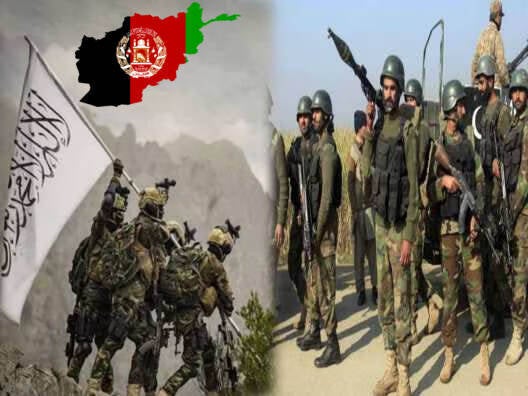Several Pakistani soldiers died in an Afghan attack; the tensions are rooted in the 132-year-old FATA dispute. Understand what it is?: Afghanistan claimed that its troops retaliated and killed 58 Pakistani soldiers.
Afghanistan-Pakistan conflict: Violent clashes have erupted once again between Pakistan and Afghanistan. Afghans allege that the Pakistani army is targeting residential areas.
In a similar incident, firing resumed on Wednesday (October 15) along the Durand Line, the border between Afghanistan and Pakistan. Due to this clash, Afghans living along the border have been forced to flee their homes. Afghans have alleged that the Pakistani army is targeting residential areas.
The escalating tensions along the border between Afghanistan and Pakistan are rooted in the 132-year-old FATA dispute. The Durand Line, established in 1893, remains a source of disagreement between the two countries. The recent clashes were triggered by a TTP attack and Pakistani airstrikes, which killed dozens of soldiers.
Tensions are currently high along the border between Afghanistan and Pakistan. On October 9, Pakistan carried out airstrikes in Kabul, Khost, Jalalabad, and Paktika. Pakistan claimed that its target was Tehreek-e-Taliban Pakistan (TTP) leader Noor Wali Mehsud. Pakistan claimed that Mehsud was hiding in Afghanistan and was being sheltered by the Afghan Taliban. However, these attacks failed, and Mehsud escaped. Subsequently, heavy gunfire erupted along the Durand Line on October 11 and 12. Pakistan claimed 23 of its soldiers were killed, while Afghanistan said 58 Pakistani soldiers were killed. Early Wednesday morning, the Pakistani army launched another attack on Afghanistan, specifically targeting the Spin Boldak district of Kandahar. Taliban spokesman Zabihullah Mujahid said 12 civilians were killed and over 100 injured in the attack. In response, the Afghan army retaliated, killing several Pakistani soldiers. Afghan forces captured their positions and outposts, seized weapons and tanks, and destroyed several military facilities. The situation was brought under control by 8 a.m. Both countries accused each other of border violations and harboring terrorists. Let's understand the root of the dispute.
What is the root of the dispute?
The area where the recent clashes occurred is Kurram district. It was once part of the Federally Administered Tribal Areas (FATA). FATA was made up of seven agencies—Bajaur, Mohmand, Khyber, Orakzai, Kurram, North Waziristan, and South Waziristan—as well as six frontier regions. High mountains, dense forests, and deep valleys, Pashtun tribes lived here. The story of FATA begins during the British era. In 1893, the British created the Durand Line, a line dividing Afghanistan and what was then British India. It was created by British officer Sir Mortimer Durand.
But the Pashtun tribes never wholeheartedly accepted this line. They used to say, "Our territory is divided." The British feared that if these tribes merged with Afghanistan, they would lose control. Therefore, they created FATA as a separate region. Here, they implemented a strict law in 1901, called the Frontier Crimes Regulation (FCR). Under the FCR, people had no freedom: no lawyers, no courts, no basic rights. The tribes ruled the roost. They were kept silent by giving money and power to the tribal chieftains.
When Pakistan was formed in 1947, Mohammad Ali Jinnah promised these tribes, "We will let you live as you are." Pakistan maintained the FCR. The Pakistani Constitution was not fully implemented in FATA. Elections were not held, schools, or hospitals were not built. People were extremely poor, with no electricity, water, or roads. But why did Pakistan keep FATA like this? It was a buffer zone. FATA was an area between Afghanistan and Pakistan. FATA created a distance between Afghanistan and Pakistan. If Afghanistan did anything, it would get entangled in FATA.
FATA became a headache for Pakistan.
When the Soviet Union occupied Afghanistan in 1979, Pakistan and the United States used FATA as a weapon. Thousands of Mujahideen came here. Training camps were set up in FATA, weapons were stored, and Mujahideen fought against the Soviets in Afghanistan. FATA kept Pakistan safe. Then, when the Taliban emerged in the 1990s, FATA also helped them. But everything has two sides.
FATA saved Pakistan, but it also became a dangerous place. Terrorist organizations like al-Qaeda flourished here. In 2007, Tehreek-e-Taliban Pakistan was formed, which launched an insurgency against Pakistan. FATA became a hotbed of terrorism. Schools were blown up, people were killed. When the US attacked Afghanistan in 2001, Taliban and al-Qaeda members hid in FATA. Tehreek-e-Taliban Pakistan did the same. They would attack the Pakistani army from FATA and then flee to Afghanistan.
When did Pakistan's problems increase?
Now let's turn to 2018. That year, Pakistan took a major decision. They merged FATA with Khyber Pakhtunkhwa province. Some Pashtun tribes wanted FATA to be made a separate province. But that buffer zone, which existed in the form of FATA, is now gone. Now the border between Afghanistan and Pakistan is directly adjacent. There is no middle ground left. Previously, if Tehreek-e-Taliban Pakistan attacked Kurram, Pakistan would say, "This is an internal matter of FATA." But now Kurram is a district of Khyber Pakhtunkhwa. The attack is directly directed at Pakistan. Meaning, the two countries are now face to face. And Pakistan is realizing that the acacia tree that the British planted was then watered and fed by Pakistan. So where will the mangoes come from now?




Add comment
Comments